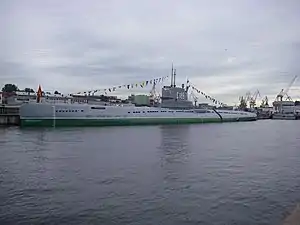 S-189 preserved and on display as a museum boat in Saint Petersburg. | |
| Class overview | |
|---|---|
| Operators | |
| Preceded by | S class |
| Succeeded by |
|
| Built |
|
| Completed | 236 (215 in the USSR + 21 in China) |
| Preserved | 2 |
| General characteristics (Project 613) | |
| Type | Diesel-electric attack submarine |
| Displacement |
|
| Length | 76 m (249 ft 4 in) |
| Beam | 6.3 m (20 ft 8 in) to 6.5 m (21 ft 4 in) |
| Draft | 4.55 m (14 ft 11 in) |
| Propulsion |
|
| Speed |
|
| Range |
|
| Endurance | Submerged: 166 h |
| Complement | 52 |
| Armament |
|
Whiskey-class submarines (known in the Soviet Union as Projects 613, 640, 644, and 665) are a class of diesel-electric attack submarines that the Soviet Union built in the early Cold War period.
Design

The initial design was developed in the early 1940s as a sea-going follow on to the S-class submarine. As a result of war experience and the capture of German technology at the end of the war, the Soviets issued a new design requirement in 1946. The revised design was developed by the Lazurit Design Bureau based in Gorkiy. Like most conventional submarines designed 1946–1960, the design was heavily influenced by the World War II German Type XXI U-boat.[1]
Patrol variants
Between 1949 and 1958 a total of 236 of an envisaged 340[2] submarines of this type were commissioned into the Soviet Navy. The vessels were initially designed as coastal patrol submarines. These patrol variants are known in the west as Whiskey I, II, III, IV, and V and were called Project 613 in the Soviet Union.
- Whiskey I − twin 25 mm (1.0 in) guns in conning tower
- Whiskey II − twin 57 mm (2.2 in) guns and twin 25 mm guns
- Whiskey III − guns removed
- Whiskey IV − 25 mm guns
- Whiskey V − no guns - streamlined conning tower and snorkel
Missile variants

In the 1950s and 1960s some Whiskey submarines were converted to guided missile submarines, with the capability to fire one to four SS-N-3 Shaddock cruise missiles. In 1956, the first prototype was ready. It was a regular Whiskey class modified with a launch tube aft of the sail containing a single SS-N-3c. This vessel was known in the West as Whiskey Single Cylinder. Between 1958 and 1960, six additional Whiskey-class submarines were converted to carry guided missiles. These boats had two missile tubes behind the sail, and were known in the west as the Whiskey Twin Cylinder, and Project 644 boats by the Soviets.[3]
Between 1960 and 1963, six boats received an extended sail that could contain four Shaddock missiles. These were called Whiskey Long Bin in the West and Project 665 in the Soviet Union.[3] All guided missile variants of the Whiskey class carried the P-5/ NATO SS-N-3c Shaddock land-attack missile, and had to surface in order to fire their missiles. The boats of the single and twin cylinder class also had to raise their missile tubes, which were normally positioned horizontally.
The "Long Bin" boats did not handle well, with the launch tubes causing stability problems, and water flow around the missile fittings was very noisy.[4] All were soon retired from service. Four were converted to Project 640 radar picket boats (called Whiskey Canvas Bag in the West). Two were converted for "fishery research" and "oceanographic research" purposes. In the Soviet Navy, the patrol variants of this class were replaced by the Romeo class. The guided missile variants were replaced by the Juliett class.
Production programme

The Soviet Union built a total of 236 or 215 Whiskeys (sources vary; it appears the initial 21 Chinese-built boats are often included with the Soviet boats). Vice Admiral Burov, head of the Soviet Defense Ministry's Shipbuilding Institute from 1969 to 1983, confirms 215 units built.[3]
| Year | Gorkiy | Nikolayev | Baltic | Komsomolsk | Total |
|---|---|---|---|---|---|
| 1951 | 1 | – | – | – | 1 |
| 1952 | 4 | 5 | – | – | 9 |
| 1953 | 19 | 11 | – | – | 30 |
| 1954 | 29 | 14 | – | 1 | 44 |
| 1955 | 37 | 18 | 8 | 4 | 67 |
| 1956 | 26 | 15 | 4 | 4 | 49 |
| 1957 | – | 9 | 3 | 2 | 14 |
| 1958 | – | – | 1 | – | 1 |
| Total | 116 | 72 | 16 | 11 | 215 |
Patrol submarines of the Whiskey class were exported to:
.svg.png.webp) Albanian People's Navy (four vessels, all retired) which were based at Porto Palermo
Albanian People's Navy (four vessels, all retired) which were based at Porto Palermo.svg.png.webp) Bulgarian Navy (two vessels, retired)
Bulgarian Navy (two vessels, retired) People's Liberation Army Navy (five vessels, and another 21 built locally from parts provided by the Soviet Union, known as Type 03, all now retired)
People's Liberation Army Navy (five vessels, and another 21 built locally from parts provided by the Soviet Union, known as Type 03, all now retired) Egyptian Navy (seven vessels, retired)
Egyptian Navy (seven vessels, retired) Indonesian Navy (twelve vessels, and two as a source of spare parts, retired)
Indonesian Navy (twelve vessels, and two as a source of spare parts, retired) Korean People's Navy (four vessels, inactive and likely retired)
Korean People's Navy (four vessels, inactive and likely retired).svg.png.webp) Polish Navy (four vessels, 1962–1986, retired)
Polish Navy (four vessels, 1962–1986, retired)
- ORP Orzeł (292)
- ORP Bielik (295)
- ORP Sokół (293)
- ORP Kondor (294) – 10 June 1965 raising of the banner, 30 October 1985 lowering of the banner.
Cuba and Syria ordered used Whiskey-class submarines for use as battery charging hulks. The ![]() Syrian Arab Navy boats were ex-Soviet Navy S-167, S-171, and S-183. The
Syrian Arab Navy boats were ex-Soviet Navy S-167, S-171, and S-183. The ![]() Cuban Revolutionary Navy acquired an ex Soviet boat for Foxtrot class submarine training. The guided missile and radar picket boats were never exported.
Cuban Revolutionary Navy acquired an ex Soviet boat for Foxtrot class submarine training. The guided missile and radar picket boats were never exported.
By 1982, only 60 boats remained in the Soviet Navy (45 active, 15 in operational reserve); all were retired by the end of the Cold War.
Incidents involving Whiskey-class submarines
- On 27 January 1961, S-80 was lost due to accidental flooding while the boat was submerged. The valve that should have prevented water from entering the snorkel did not work properly.
- On 24 November 1972, the Kobben-class submarine KNM Sklinna of the Royal Norwegian Navy had "contact" with what they presumed was a Whiskey-class submarine, after 14 days of "hunt" in Sognefjord. Military documents released in 2009 confirm this episode.[5]
- On 21 October 1981, S-178 was run down by the merchant vessel Refrizherator-13 in Golden Horn Bay, Vladivostok.
- On 27 October 1981, S-363 ran aground in Swedish territorial waters near the Karlskrona naval base.
- On 19 June 1984, a Whiskey-class submarine was caught in a fishing-net and surfaced within the Norwegian economic exclusive zone.[6]
- On 14 December 1989 a decommissioned Whiskey class soviet submarine under tow for scrapping in Nakskov was sunk 2 miles west of Bornholm. Attempts to raise it in 1991 failed and it sunk nearby in deeper water. [7]
- On 5 February 2007, the decommissioned S-194 took on water and sank off the coast of Denmark while being towed to become part of a naval museum.[8]
- In 2009 a previously unknown and unidentified sunken Whiskey-class submarine was discovered within Sweden's EEZ close to the island of Gotland. It was a decommissioned submarine which sank while under tow to be scrapped in Denmark. News of the discovery was not made public until March 2011.[9][10]
Surviving examples
S-189 is preserved as a museum in Saint Petersburg, Russia. KRI Pasopati (ex-S-290) is preserved in Surabaya, Indonesia.Sub 105 is preserved at Pashaliman base in south Albania
Notes
- ↑ Friedman, pp. 396–397
- ↑ Kuzin, V.P.; Nikolskiy V.I. Voyenno-morskoy Flot SSSR 1945-1991. Istoricheskoye Morskoye Obshchestvo, Sankt Peterburg, 1996
- 1 2 3 Burov, V.N. Otechestvennoye Voyennoye Korablestroyeniye v Tretem Stoletii Svoyey Istorii, Sudostroyeniye, Sankt Peterburg, 1995. 5-7355-0508-4
- ↑ Weir and Boyle 2003
- ↑ Aftenposten(Norwegian Language) (including pictures)
- ↑ AS, TV 2 (21 October 2014). "Skipperen Onar (68) fikk denne russiske ubåten i trålen". TV 2 (in Norwegian Bokmål). Retrieved 2020-04-05.
{{cite web}}: CS1 maint: numeric names: authors list (link) - ↑ vragguiden.dk
- ↑ Dansk Dykkerservice ApS (Danish Language) Archived 2008-09-25 at the Wayback Machine (including pictures)
- ↑ "JP.dk". Archived from the original on 2011-04-06. Retrieved 2011-03-05.
- ↑ Forsvarsmakten.se
References
- Friedman, Norman (1995). "Soviet Union 1947–1991: Russian Federation and Successor States 1991–". In Chumbley, Stephen (ed.). Conway's All the World's Fighting Ships 1947–1995. Annapolis, Maryland: Naval Institute Press. pp. 337–426. ISBN 1-55750-132-7.
- Hampshire, Edward (2018). Soviet Cruise Missile Submarines of the Cold War. London: Osprey Publishing. ISBN 978-1-47282-499-8.
- Pavlov, A. S. (1997). Warships of the USSR and Russia 1945–1995. Annapolis, Maryland: Naval Institute Press. ISBN 1-55750-671-X.
- Polmar, Norman & Moore, Kenneth J. (2004). Cold War Submarines: The Design and Construction of U.S. and Soviet Submarines. Washington, D. C.: Potomac Books. ISBN 978-1-57488-594-1.
- Polmar, Norman & Noot, Jurrien (1991). Submarines of the Russian and Soviet Navies, 1718–1990. Annapolis, Maryland: Naval Institute Press. ISBN 0-87021-570-1.
- Vilches Alarcón, Alejandro A. (2022). From Juliettes to Yasens: Development and Operational History of Soviet Cruise-Missile Submarines. Europe @ War (22). Warwick, UK: Helion & Co. ISBN 978-1-915070-68-5.
- Weir, Gary E., and Boyle, Walter J. Rising Tide: The Untold Story of the Russian Submarines That Fought the Cold War Basic Books, 2003.